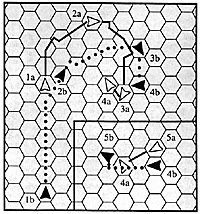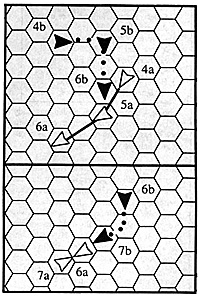Reactionary Play
 At right, a Bf 109E-4 (black) at speed
7.0 has jumped a Spitfire Mk.1 (white) at
speed 5.5. Both aircraft are in right banks,
at altitude 15.0, and starting from level
flight. On turn one the Spitfire is tailed so
its player opts to break fight (turning in a 2-
1-2-1 pattern). The 109E player, a simple
minded reactionary, follows doing an HT
turn and carrying another HT forward
while taking a range four pot-shot which
misses.
At right, a Bf 109E-4 (black) at speed
7.0 has jumped a Spitfire Mk.1 (white) at
speed 5.5. Both aircraft are in right banks,
at altitude 15.0, and starting from level
flight. On turn one the Spitfire is tailed so
its player opts to break fight (turning in a 2-
1-2-1 pattern). The 109E player, a simple
minded reactionary, follows doing an HT
turn and carrying another HT forward
while taking a range four pot-shot which
misses.
He believes he has positional superiority but is no longer tailing (a possible mistake). On turn two, the 109E player is lucky enough to win initiative. The Spitfire player has to force an overshoot, so he continues the break turn around while starting a slight zoom climb in order to gain additional maneuvering options. The Bf 109E player, competent enough to see the flow of the fight developing and his own impending overshoot. but unable to think of any alternative, desperately tries to hang on by selecting idle power and turning as hard as he dares (including one ET, risking GLOC and wing damage for it - which he luckily avoids).
He also climbs to match the Spitfire and limit his horizontal overshoot. The zoom, he correctly reasons, positions the 109's nose to follow any vertical moves the Spitfire may choose next turn (assuming the 109 wins initiative again - which, amazingly, it does).
The Spitfire pilot, cursing the German',, luck, follows through on his plan to spill the 109 off his tail. Continuing the zoom he uses three VFPs and an HFF while in a continuous break turn. The 109 pilot, unable to pull BTs, elects a vertical climb to roll up and behind the Spitfire, earning himself a smug feeling of superiority due to his position (he ha, screwed himself, however).
The German pilot wins initiative yet again, but this time, the RAF player merely smile, as he pitches into the vertical and makes his move. By using a snap roll bank, and by using his carried half FP in this turn to form another HFP, he rolls to face the 109's rear, shifts two hexes and then vertically reverses back toward the 109.
Momentarily shocked, the 109 driver checks the situation. He car see that, regardless of what he does he's going to end up out in front of the Spitfire. He can either run for it, or go vertical and shift away from, or toward the Spitfire. As going vertical will only slow him down more and probably get him shot at this turn or give the Spitfire good tailing parameters, he decides to run. With good play he should escape (he doesn't). Below are short summaries of the Spitfire and 109 moves:
- Turn 1 Spitfire: Level flight,
emerg pwr., 2 HFP (BT to NNE), 1 HFP
(BT t( NE), 2 HFP (BT to E). End speed =
5.5+.5 K decel carried). End altitude
15.0. End bank = right bank.
Turn 1 Bf 109E: Level flight, emerg pwr., 5 HFP (HT to NNE), 2 HFP (carn, two HT FPs right). End speed = 7.0 (" decel carried). End altitude = 15.0 End bank = right bank.
Turn 2 Spitfire: Zoom climb, emerg pwr., 1 HFP (BT to SE), 1 HFP + 1 VF1 (+ 100) (BT to SSE), 1 HFP (BT to S), , HFP (BT to SSW). End speed = 4.5 K decel carried). End altitude = 15 1. End bank = right bank.
Turn 2 Bf 109E: Zoom climb, idle (speed 6.5), HFP (finish HT to NE), HFP (BT to E), 2 HFP (13to SE), 1 VFP (ET to SSE) End speed = 4.5 +.5 1, decel carried). End altitude = 15. 1. End bank = right bank.
Turn 3 Spitfire: Zoom climb, emerg. pwr., 3 VHI (+ 500) (BT three times to face NW), 1 HFP (BT to face NNW). End speed = 2.5+.5 (3 decel carried) End altitude = 15.6. En( bank = right bank.
Turn 3 Bf 109E: Verticz climb, emerg. pwr., 2 VFI (+ 500) (bank to face S), HFP + 1VHP (+300) (bank to face W, end bank declared as inverted right). End speed = 3.0 (3 decel carried). End alt. = 15.9.
Turn 4 Spitfire: Vertical climb, emerg. pwr., 1 VFP 1+ 200) (snap roll to face NE), 2 HFP (declare vertical reverse to face SW). End speed = 2.0 (4 decel carried). End altitude = 15.8. End bank inverted right.
Turn 4 Bf 109E: Level, emerg. pwr., 3 HFP (EZ turn to face NW. and bank to end turn in upright right bank). End speed = 3.5 ( 1 accel carried), End attitude = 15.9.
Anticipatory Play
In the first example, the 109 driver was led into a position where he overshot and had to run for it despite having initiative on every game turn. He committed a number of cardinal 109 sins as well, such as turning with a Spitfire and giving up energy uselessly.
 In the following example, the 109 pilot
refuses to play the Spitfire's turning game.
Instead, he capitalizes on his superior
start speed and moves to force the Spitfire
to react to him. On turn one, the Spitfire's
move is identical to the one in the
previous example. The 109's move is
slightly different however. It does only one
HT turn to conserve energy and takes the
range four shot (assume a miss again).
In the following example, the 109 pilot
refuses to play the Spitfire's turning game.
Instead, he capitalizes on his superior
start speed and moves to force the Spitfire
to react to him. On turn one, the Spitfire's
move is identical to the one in the
previous example. The 109's move is
slightly different however. It does only one
HT turn to conserve energy and takes the
range four shot (assume a miss again).
The Spitfire wins initiative on turn two so the 109 pilot initiates a steep zoom climb while moving toward the Spitfire. No turns are done in order to conserve energy. The Spitfire pilot, seeing the 109 perching high, decides to face the enemy as quickly as possible. He break turns around while also zoom climbing to negate the 109's vertical turning room. This move is a tactical mistake, though, since the combined turn and steep climb cost the Spitfire most of its energy (it would have been better to extend out or dive away, but that is not in this Spitfire player's mentality - he's too used to kicking 109 butt).
Luckily for him, the Spitfire wins initiative again on turn three, so the 109 driver elects to increase his altitude advantage by vertically climbing while banking twice to position himself further away from the Spitfire. The 109 also ends with a vertical reverse to face the Spitfire and bank inverted in order to be able to start down quickly if the opportunity arises. The Spitfire pilot, seeing no good shot opportunity, elects to level off and rebuild energy. This is another error even though it seems reasonable at the moment (a better move would have been to continue climbing directly toward the 109).
Through incredible bad luck, the 109E loses initiative yet again. Exasperated but undaunted, the 109 driver stays in the vertical climb while remaining in an inverted right bank. He takes advantage of a half FP carry to net an extra HFP and moves forward two spaces while banking to face south toward the Spitfire. The Spitfire pilot opts to stay level again to build up energy while performing an EZ turn to keep the 109 out of his blind arc.
As turn six begins, the 109 loses initiative again (this after changing dice for the third time). He decides to pull down into level flight, while remaining inverted and float toward the Spitfire. The "limey" pilot, feeling safe for the moment, continues straight ahead while starting a zoom climb. This puts the 109 in his blind arc giving the German pilot the initiative. The Spitfire pilot is unconcerned, however, knowing that he will be looping back toward the 109 next turn.
 On turn six, the Spitfire, pitches into
the vertical and does a vertical reverse to
face the incoming 109. The 109 pilot
elects a steep dive, chops power to idle
(speed now 2.5 +.5) and does two EZ
turns while banking back to an upright
banked attitude and then starting a third
EZ turn (he uses the steep dive inverted
turning bonus on the first two Us).
This lines him up on the Spitfire's nose
with enough time for a long burst.
On turn six, the Spitfire, pitches into
the vertical and does a vertical reverse to
face the incoming 109. The 109 pilot
elects a steep dive, chops power to idle
(speed now 2.5 +.5) and does two EZ
turns while banking back to an upright
banked attitude and then starting a third
EZ turn (he uses the steep dive inverted
turning bonus on the first two Us).
This lines him up on the Spitfire's nose
with enough time for a long burst.
He ends at range two for a head on shot and succeeds in his determination roll. This gives him a 2-1 upped to a 3-1 for the long burst with a -1 harmony modifier. The die roll is a six, which is modified down to a five for four hits and two criticals. Though the overall damage is slight, it is enough. One critical starts a minor engine fire and the other results in the landing gear jammed up. The Spitfire pilot is unable to shoot back since the 109 pilot was in his blind arc at the start of the Spitfire's own move.
As for collisions, the fact that the Spitfire is not firing back and that the 109 is still turning and that both are fairly slow reduced the risk to 10% which is reasonable (no collision resulted this time). To make a long story short, the two aircraft passed and as they extended away from each other for energy, the Spitfire's minor fire progressed into a major one and the RAF pilot opted for a silk letdown, ending the fight.
More Situational Awareness for Fighting Wings,
- Situational Awareness: Introduction
Situational Awareness: Reactionary and Anticipatory Play
Situational Awareness: Learning Points and Conclusion
Back to Art of War Issue #30 Table of Contents
Back to Art of War List of Issues
Back to MagWeb Master Magazine List
© Copyright 1999 by Clash of Arms Games.
This article appears in MagWeb (Magazine Web) on the Internet World Wide Web.
Other military history articles and gaming articles are available at http://www.magweb.com